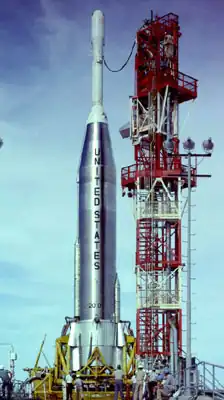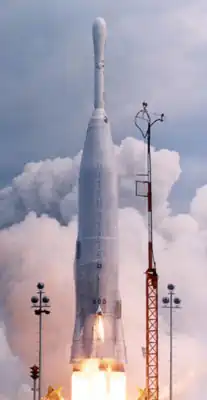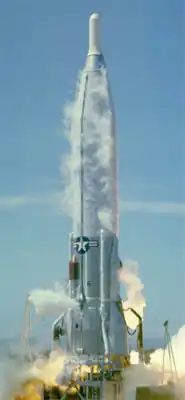Atlas-Able
 The Atlas-D Able rocket carrying Pioneer P-3, sitting on Cape Canaveral's Launch Complex 14. | |
| Manufacturer | Convair Division of General Dynamics |
|---|---|
| Country of origin | United States |
| Size | |
| Height | 28 m (91 ft) |
| Diameter | 3.05 m (10 ft) |
| Stages | 3.5 |
| Booster stage – Half Stage | |
| Powered by | 2 |
| Maximum thrust | 300,000 lbf (1,300 kN) Atlas D |
| Propellant | RP-1/LOX |
| First stage – Sustainer | |
| Powered by | 1 |
| Maximum thrust | 60,000 lbf (270 kN) Atlas D |
| Propellant | RP-1/LOX |
| Second stage – Able | |
| Powered by | 1 AJ10-37 |
| Maximum thrust | 7,800 lbf (35 kN) |
| Specific impulse | 270 |
| Burn time | 115 |
| Propellant | Nitric Acid / UDMH |
| Third stage – Altair | |
| Powered by | 1 |
| Propellant | solid |
| Capacity | |
| Payload to Trans-lunar injection | |
| Mass | 168 kg (370 lb) |
| Launch history | |
| Status | Retired |
| Launch sites | LC-12, 13 & 14, Cape Canaveral |
| Total launches | 3 |
| Failure(s) | 3 |
| First flight | 26 November 1959 |
| Last flight | 15 December 1960 |
The Atlas-Able was an American expendable launch system derived from the SM-65 Atlas missile. It was a member of the Atlas family of rockets, and was used to launch several Pioneer spacecraft towards the Moon. Of the five Atlas-Able rockets built, two failed during static firings, and the other three failed to reach orbit.[1]
The Atlas-Able was a three-and-a-half-stage rocket, with a stage-and-a-half Atlas missile as the first stage, an Able second stage, and an Altair third stage.[2]
The first Atlas-Able used an Atlas C as the first stage,[3] and was intended to carry Pioneer P-1, but exploded during a static fire test on 24 September 1959.[4]
The remaining Pioneer launches used Atlas D missiles. Launches were conducted from Launch Complexes 12 and 14 at the Cape Canaveral Air Force Station. One launch was planned from Launch Complex 13; this became the second Atlas-Able to be destroyed during a static firing, and hence never launched.[1]
Launches
| Date | Serial No. | Mission | Launch Site | Outcome | Photo | |
|---|---|---|---|---|---|---|
| - | Atlas 9C | Pioneer P-1 | LC-12 | Failure. Explosion during a static fire test.[5] | ||
| 26 November 1959 | Atlas 20D | Pioneer P-3 | LC-14 | Failure. The Payload fairing broke up at 45 seconds after liftoff, causing loss of the upper stage and payload.[6]: 24 | ||
| 25 September 1960 | Atlas 80D | Pioneer P-30 | LC-12 | Failure.[7] A propellant feed on the second stage had a malfunction.[6]: 26 | 
|
|
| 15 December 1960 | Atlas 91D | Pioneer P-31 | LC-12 | Failure.[8] Vibration and/or debris from the Able adapter section ruptured the liquid oxygen tank of Atlas, causing an explosion. |
References
- ^ a b Wade (2008-08-14). "Atlas". Encyclopedia Astronautica. Archived from the original on 2008-08-14. Retrieved 2024-09-19.
- ^ a b Krebs, Gunter D. "Atlas-D Able". Gunter's Space Page. Retrieved July 6, 2025.
- ^ a b Krebs, Gunter D. "Atlas-C Able". Gunter's Space Page. Retrieved July 6, 2025.
- ^ LePage, Andrew (December 13, 2010). "The Pioneer lunar orbiters: a forgotten failure". The Space Review. Retrieved 2024-09-19.
- ^ "U.S. Moon Rocket Blows Up in Static Test". Tulare Advance-Register. September 24, 1959. Retrieved July 6, 2025 – via newspapers.com.
- ^ a b Siddiqi, A.A. (2002). Deep Space Chronicle (SP-2002-4524) (PDF) (Report). NASA. Retrieved May 24, 2025.
- ^ "U.S. Fails In Pioneer Shot". Standard-Speaker. September 26, 1960. p. 2. Retrieved July 6, 2025 – via newspapers.com.
- ^ Finney, John W. (December 17, 1960). "Reach of U.S. Scientists Into Space Still Exceeds Grasp Of Their Rockets". The Bangor Daily News. p. 7. Retrieved July 6, 2025 – via newspapers.com.
